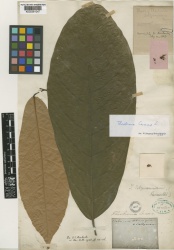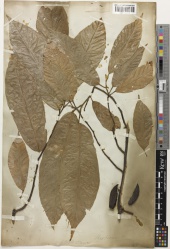Theobroma cacao (fruit)
From AHPA Botanical Identity References Compendium
(Difference between revisions)
(add USD 1918 information (organoleptic and macroscopic)) |
(add Kew voucher specimen reference) |
||
| Line 13: | Line 13: | ||
=Botanical Voucher Specimen= | =Botanical Voucher Specimen= | ||
| + | {{Media2 |cat=Voucher | ||
| + | | companyimage=Kewlogo.gif | ||
| + | | companyURL=http://specimens.kew.org/herbarium/K000381047 | ||
| + | | mainimage=Theobroma cacao Kew barcode=K000381047 225205.jpg | ||
| + | | source=Royal Botanic Gardens, Kew. | ||
| + | |||
| + | | companyimage2=Kewlogo.gif | ||
| + | | companyURL2=http://specimens.kew.org/herbarium/K001132315 | ||
| + | | image2=Theobroma cacao Kew barcode=K001132315 713127.jpg | ||
| + | | source2=Royal Botanic Gardens, Kew. | ||
| + | }} | ||
=Organoleptic Characteristics= | =Organoleptic Characteristics= | ||
{| border=1 | {| border=1 | ||
Revision as of 18:05, 26 May 2015
Contents |
Nomenclature
Theobroma cacao L. Sterculiaceae
Standardized common name (English): cacao
Botanical Voucher Specimen
 |
 |
|
|
|
Organoleptic Characteristics
|
Macroscopic Characteristics
|
Microscopic Characteristics
High Performance Thin Layer Chromatographic Identification
Supplementary Information
Sources
- ↑ Royal Botanic Gardens, Kew. http://specimens.kew.org/herbarium/K000381047
- ↑ Royal Botanic Gardens, Kew. http://specimens.kew.org/herbarium/K001132315
- ↑ United States Dispensatory (1918)
- ↑ United States Dispensatory (1918)

